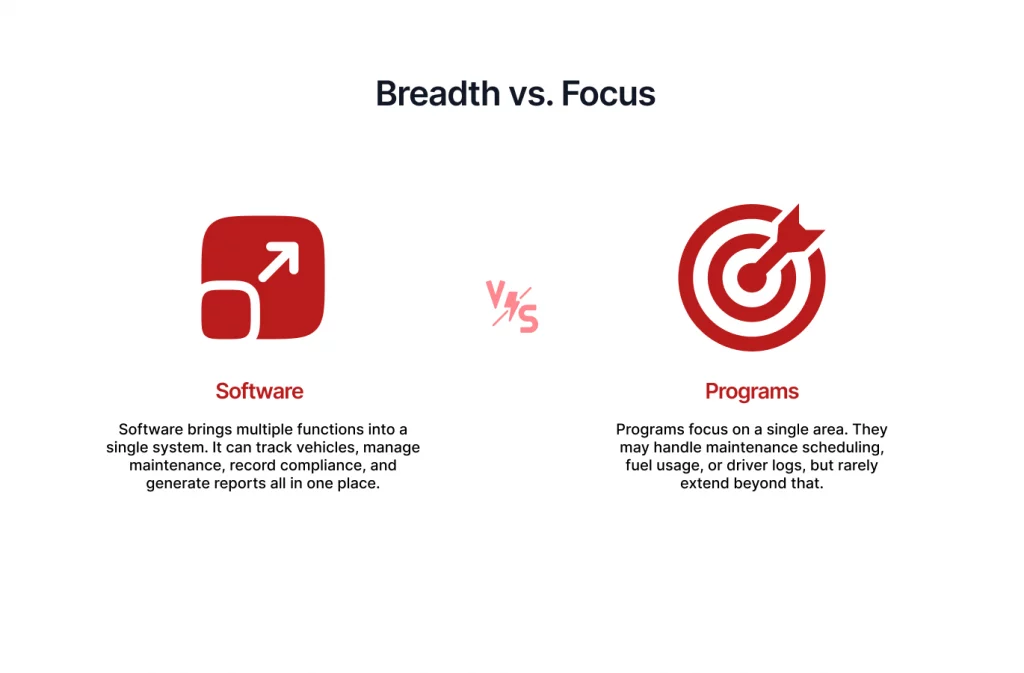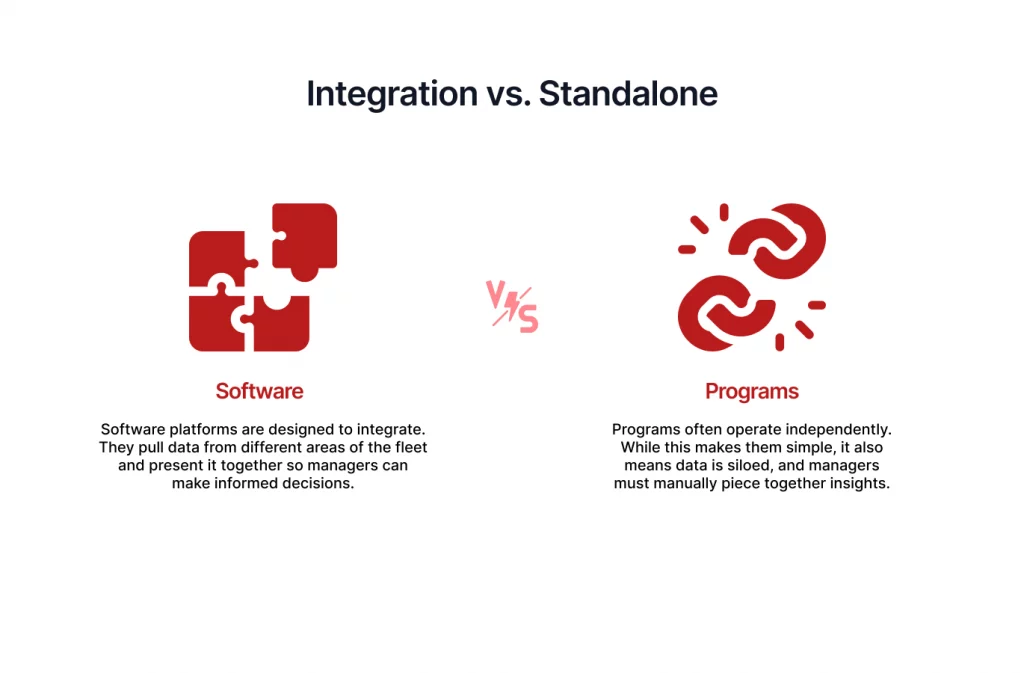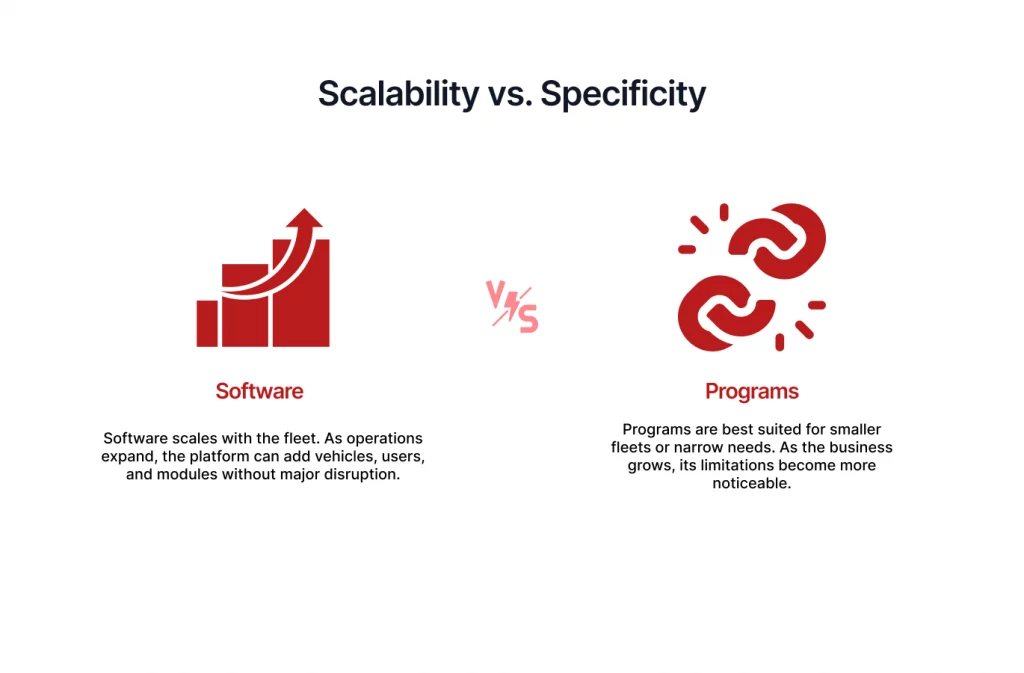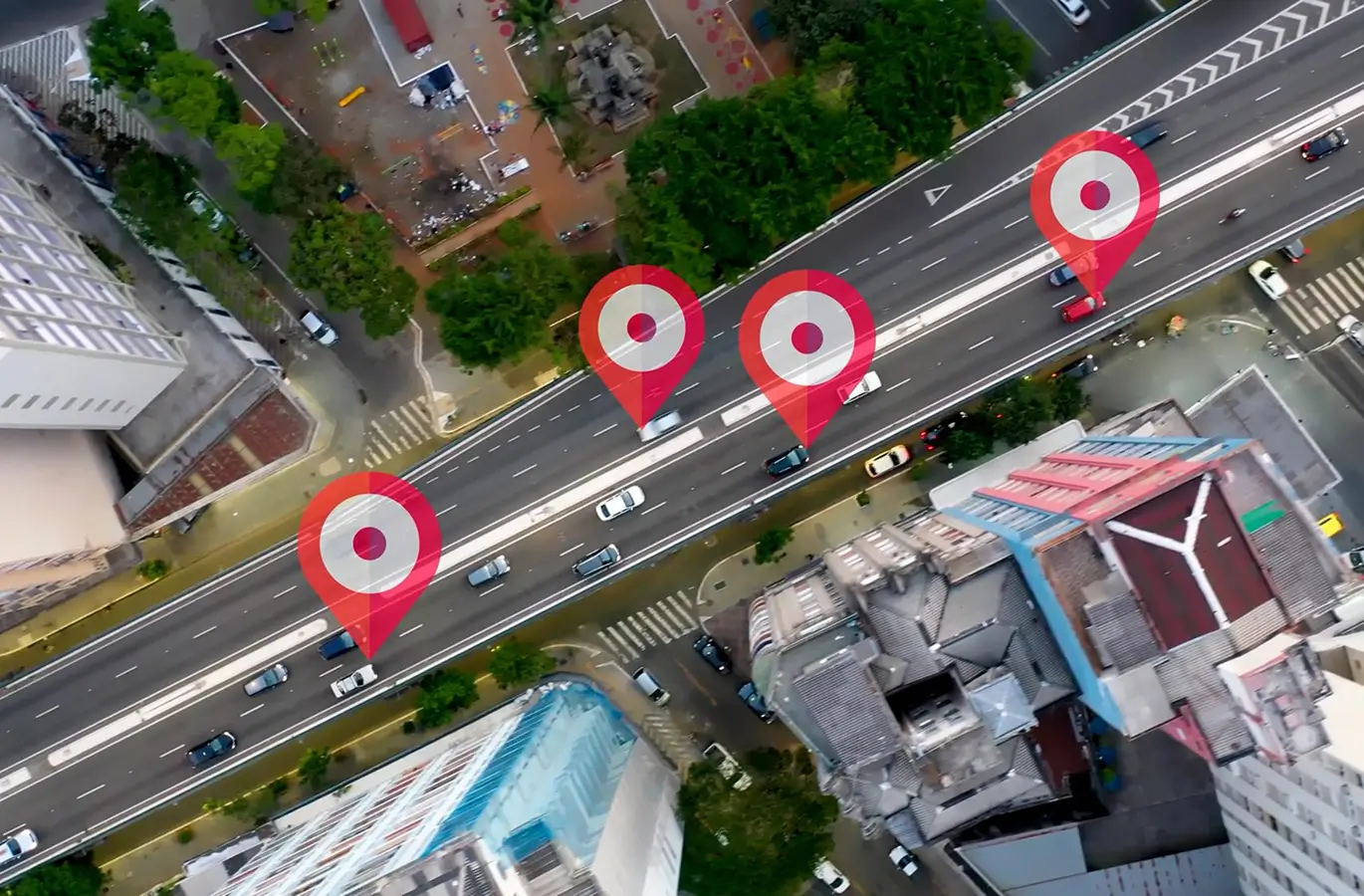Fleet managers today face no shortage of technology options. Every vendor promises efficiency, compliance, and reduced costs, but the language used to describe these tools can be confusing. Terms like fleet management software and fleet management programs are often used interchangeably. Yet, they are not always the same thing. Understanding the distinction is important for making the right choice in 2026.
At the broadest level, software usually refers to comprehensive platforms that bring multiple functions into one system. These may include tracking, compliance, maintenance, and reporting. Programs, by contrast, are narrower in scope. They are often designed to handle a specific task, such as preventive maintenance scheduling, fuel tracking, or driver logging. Both approaches can add value, but the difference lies in scope, scalability, and long-term impact.
For fleet operators, mixing up the two terms can lead to mismatched expectations. Choosing a lightweight program when a platform is needed can create gaps in compliance and visibility. On the other hand, investing in a full-featured software suite when only targeted functionality is required can add unnecessary complexity.
This article explains the differences between fleet management software and programs, highlights where they overlap. It shows why the real priority is not the label but the outcomes. REACH is a modern platform that combines the practicality of programs with the breadth of software, giving fleets the clarity and performance they need in 2026.
Defining Fleet Management Software
Fleet management software is the broader, more comprehensive category of digital tools available to operators. These platforms are designed to integrate many aspects of fleet operations into a single system. Instead of managing compliance in one program, maintenance in another, and driver records in a third, software brings everything under one roof.
A typical fleet management software suite in 2026 includes:
- Vehicle tracking and telematics: Real-time GPS data, driver behavior monitoring, and route history.
- Maintenance management: Preventive schedules, automated reminders, and repair histories.
- Compliance management: Digital driver vehicle inspection reports (DVIRs), hours of service records, and audit-ready reporting.
- Analytics and reporting: Dashboards that allow managers to monitor costs, fuel use, and downtime across the entire fleet.
This scope is what makes fleet management software attractive. It is not simply a tool for one task; it is a framework that allows operators to manage all the moving parts of a fleet in one place.
Advantages of Fleet Management Software
- Integration of multiple functions: By combining tracking, compliance, and maintenance, the software provides visibility across the fleet.
- Scalability: Comprehensive platforms are built to grow with the fleet, supporting both small regional operators and large enterprises.
- Data-driven decision making: With data centralized, managers can spot patterns and reduce costs.
Limitations to Be Aware Of
While comprehensive fleet management software can also be complex, rollouts often take time, and some systems include more modules than a fleet realistically needs. This can create a steep learning curve and add to operational overhead. The cost structure of full-featured platforms can also be challenging for smaller fleets.
Where REACH Fits
This is where REACH differentiates itself. It provides the scope and depth expected of a fleet management software platform but avoids the trap of overcomplication. Compliance and service coordination are at the center, and every feature is designed to support uptime and operational clarity. REACH offers the power of a platform without forcing fleets to navigate modules they will never use.
Defining Fleet Management Programs
Fleet management programs are often more limited in scope compared to full software platforms. Instead of integrating many functions into a single system, programs are usually designed to solve a specific operational challenge. They are narrower, lighter, and often easier to deploy.
Examples of common fleet management programs include:
- Maintenance tracking programs that schedule preventive service, log completed repairs, and generate reminders.
- Fuel management programs that monitor fuel card use, track consumption, and flag unusual activity.
- Driver safety programs that record incidents, monitor training progress, or handle compliance paperwork.
Advantages of Fleet Management Programs
- Simplicity: Programs are straightforward to adopt. A small fleet can quickly roll out a maintenance or fuel program without needing IT support.
- Lower cost: Since they are built to handle specific tasks, programs are often more affordable than full software platforms.
- Quick results: Because they focus on one area, programs can start delivering benefits almost immediately.
Limitations of Programs
The same qualities that make programs simple also make them limited. A maintenance program may track repairs, but will not provide visibility into compliance. A fuel program may flag misuse, but will not connect those insights to service workflows. Over time, fleets that rely solely on programs often end up managing multiple disconnected systems. This creates silos, increases administrative work, and makes it harder to see the bigger picture.
Programs can also struggle to scale. What works for a fleet of 20 vehicles may not hold up when the fleet grows to 200. As operations expand, the lack of integration becomes more obvious, forcing managers to adopt additional tools or migrate to a more comprehensive platform.
Where REACH Offers an Alternative
REACH combines the strengths of programs with the depth of software. It is as lean and easy to adopt as a program. Still, it integrates core functions like compliance and service coordination in a way that scales with growth. For fleets that do not want to choose between a program’s simplicity and a platform’s breadth, REACH provides a balanced solution.
Key Differences and Overlap
Fleet management software and fleet management programs are often confused because both are digital solutions that improve efficiency. The distinction comes down to breadth, scalability, and how they fit into daily operations.
Breadth vs. Focus

Integration vs. Standalone

Scalability vs. Specificity

Where They Overlap
There is overlap between the two. Many programs evolve into software suites by adding new functions over time. Likewise, software platforms often start with a strong core module before expanding into new areas. This is why the terminology is sometimes blurred in the industry.
The Practical Takeaway
The difference matters because it shapes expectations. Fleets choosing a program should understand its limits, while fleets investing in software should be prepared for more complexity. The right choice depends on operational priorities, but the ultimate goal remains the same: keeping vehicles compliant, reducing downtime, and improving profitability.
Why Fleets in 2026 Need More Than a Label
The debate between software and programs can be useful for definitions. Still, in practice, most fleets are less concerned with terminology and more focused on outcomes. Whether a solution calls itself a program or a software suite, what matters is whether it solves the problems that impact compliance, uptime, and profitability.
Fleet managers in 2026 are under growing pressure. Regulations are stricter, customers expect faster service, and downtime costs continue to rise. In this environment, the real question is not “Do I need software or a program?” but “Will this system keep my fleet compliant, service-ready, and reliable?”
Why Labels Fall Short
- A program that looks simple may leave compliance gaps or fail to scale as the fleet grows.
- A software suite that promises everything may burden operators with unnecessary complexity.
- Both risks highlight the need for balance rather than a rigid label.
How REACH Provides the Balance
REACH demonstrates that fleets do not have to choose between the simplicity of programs and the depth of software. It combines the lean, easy-to-use qualities of a program with the breadth and integration of a platform. Compliance is native, service workflows are digitized, and visibility is streamlined. As a result, fleets of all sizes can deploy quickly, scale with confidence, and realize tangible ROI without being overwhelmed.
The Real Priority
What fleets need in 2026 is clarity, not categories. The right platform should reduce risk, cut downtime, and improve daily operations. REACH is an example of how a solution can transcend the software versus program debate and deliver what truly matters.
Beyond Software vs. Programs
The terms fleet management software and fleet management programs are often used interchangeably, but they are not identical. Software generally refers to comprehensive platforms that integrate multiple functions, while programs are narrower tools focused on a specific task. Both have value, yet both also have limits. Programs can be simple but lack scalability, and software can be powerful but risk becoming overly complex.
In 2026, the most important consideration is not which label a solution carries, but whether it delivers measurable results. The right system should protect fleets from compliance risks, reduce downtime through digitized service workflows, and provide clear visibility into daily operations.
This is exactly where REACH excels. It combines the practicality and ease of use that operators expect from a program with the breadth and integration of software, all while keeping compliance and uptime at the center. For fleets navigating a crowded market, REACH offers clarity and performance without compromise.
The debate between software and programs may continue. Still, the fleets that thrive will be the ones that choose solutions that go beyond the label and focus on impact.
Key Takeaways
Fleet management software provides a comprehensive solution for tracking, compliance, maintenance, and reporting. It suits fleets that need central visibility and plan to scale.
Fleet management programs are focused tools designed for specific tasks, such as fuel tracking or maintenance logs. They are quick to adopt, but can create silos as the fleet grows.
Choosing between software and programs depends on your operational needs. Small fleets may prefer programs for simplicity, while growing fleets often need full-featured platforms.
REACH combines the strengths of both. It is lightweight enough to be adopted as a program. Still, it provides the depth of a software platform focused on compliance and service uptime.
Integration matters. Managing multiple programs may be effective in the short term, but it ultimately leads to fragmentation. Software brings everything together for smoother daily operations.
Scalability is key. What works for 20 vehicles may not work for 200. Platforms like REACH scale alongside your business without added complexity.
Terminology is not the priority. The focus should be on real-world impact—keeping vehicles compliant, reducing downtime, and maintaining operational clarity.
REACH stands apart because it provides fleet managers with what they need without forcing them to choose between depth and ease of use. It fits seamlessly into any stage of growth.
Frequently Asked Questions (FAQ)
-
What is the difference between fleet management software and programs?
Fleet management software is a comprehensive platform that integrates multiple functions, such as compliance, maintenance, and tracking, into one system. Programs are usually single-purpose tools designed for a specific task, such as fuel tracking or maintenance scheduling.
-
Which is better: fleet management software or programs?
Neither is inherently better; the choice depends on your needs. Programs are simple and cost-effective for small, focused tasks. At the same time, software provides broader visibility and scalability for fleets that need an integrated solution.
-
Why can programs fall short as fleets grow?
Programs are often limited to one area of operation. As fleets expand, these tools may not provide the full visibility required, forcing managers to juggle multiple disconnected systems.
-
What are the drawbacks of fleet management software?
Comprehensive software can be complex, with more features than a fleet might need. Rollouts may take longer, and the cost can be higher compared to lightweight programs.
-
How does REACH fit into the software vs. program debate?
REACH combines the practicality of a program with the integration of a software platform. It keeps compliance and service workflows at the core, offering fleets a balanced solution that is easy to adopt yet scalable for growth.



